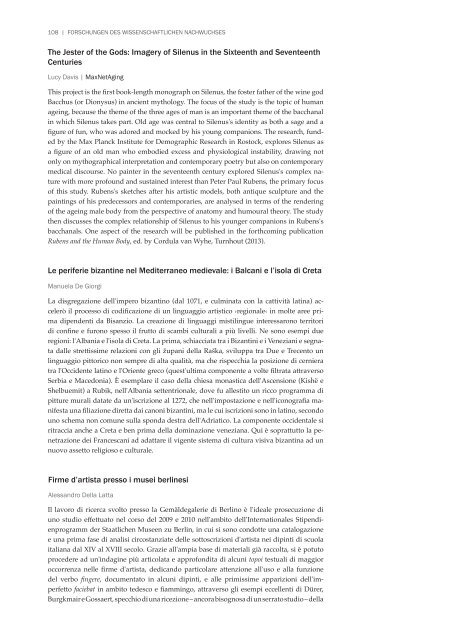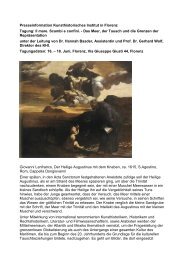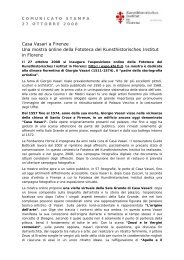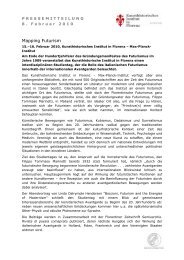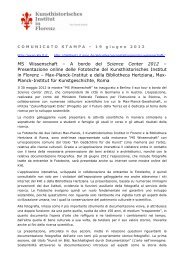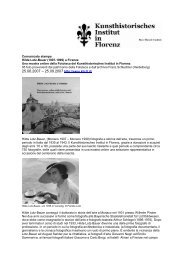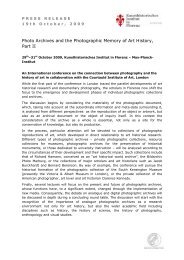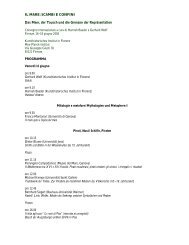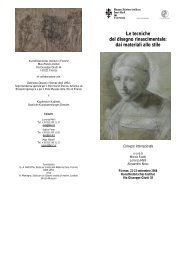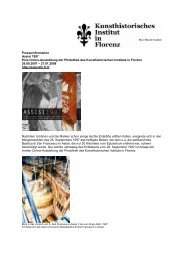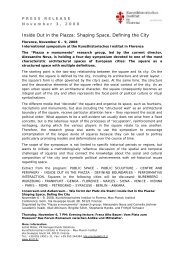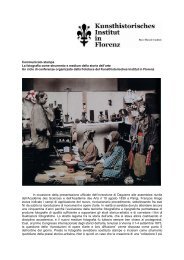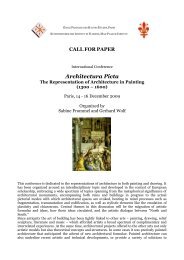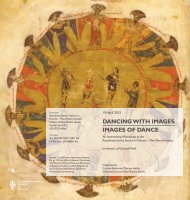forschungsbericht november 2008 – juli 2012 - Kunsthistorisches ...
forschungsbericht november 2008 – juli 2012 - Kunsthistorisches ...
forschungsbericht november 2008 – juli 2012 - Kunsthistorisches ...
Erfolgreiche ePaper selbst erstellen
Machen Sie aus Ihren PDF Publikationen ein blätterbares Flipbook mit unserer einzigartigen Google optimierten e-Paper Software.
108 | FORSCHUNGEN DES WISSENSCHAFTLICHEN NACHWUCHSES<br />
The Jester of the Gods: Imagery of Silenus in the Sixteenth and Seventeenth<br />
Centuries<br />
Lucy Davis | MaxNetAging<br />
This project is the first book-length monograph on Silenus, the foster father of the wine god<br />
Bacchus (or Dionysus) in ancient mythology. The focus of the study is the topic of human<br />
ageing, because the theme of the three ages of man is an important theme of the bacchanal<br />
in which Silenus takes part. Old age was central to Silenus's identity as both a sage and a<br />
figure of fun, who was adored and mocked by his young companions. The research, funded<br />
by the Max Planck Institute for Demographic Research in Rostock, explores Silenus as<br />
a figure of an old man who embodied excess and physiological instability, drawing not<br />
only on mythographical interpretation and contemporary poetry but also on contemporary<br />
medical discourse. No painter in the seventeenth century explored Silenus's complex nature<br />
with more profound and sustained interest than Peter Paul Rubens, the primary focus<br />
of this study. Rubens's sketches after his artistic models, both antique sculpture and the<br />
paintings of his predecessors and contemporaries, are analysed in terms of the rendering<br />
of the ageing male body from the perspective of anatomy and humoural theory. The study<br />
then discusses the complex relationship of Silenus to his younger companions in Rubens's<br />
bacchanals. One aspect of the research will be published in the forthcoming publication<br />
Rubens and the Human Body, ed. by Cordula van Wyhe, Turnhout (2013).<br />
Le periferie bizantine nel Mediterraneo medievale: i Balcani e l’isola di Creta<br />
Manuela De Giorgi<br />
La disgregazione dell'impero bizantino (dal 1071, e culminata con la cattività latina) accelerò<br />
il processo di codificazione di un linguaggio artistico ›regionale‹ in molte aree prima<br />
dipendenti da Bisanzio. La creazione di linguaggi mistilingue interessarono territori<br />
di confine e furono spesso il frutto di scambi culturali a più livelli. Ne sono esempi due<br />
regioni: l'Albania e l'isola di Creta. La prima, schiacciata tra i Bizantini e i Veneziani e segnata<br />
dalle strettissime relazioni con gli župani della Raška, sviluppa tra Due e Trecento un<br />
linguaggio pittorico non sempre di alta qualità, ma che rispecchia la posizione di cerniera<br />
tra l'Occidente latino e l'Oriente greco (quest'ultima componente a volte filtrata attraverso<br />
Serbia e Macedonia). È esemplare il caso della chiesa monastica dell'Ascensione (Kishё e<br />
Shelbuemit) a Rubik, nell'Albania settentrionale, dove fu allestito un ricco programma di<br />
pitture murali datate da un'iscrizione al 1272, che nell'impostazione e nell'iconografia manifesta<br />
una filiazione diretta dai canoni bizantini, ma le cui iscrizioni sono in latino, secondo<br />
uno schema non comune sulla sponda destra dell'Adriatico. La componente occidentale si<br />
ritraccia anche a Creta e ben prima della dominazione veneziana. Qui è soprattutto la penetrazione<br />
dei Francescani ad adattare il vigente sistema di cultura visiva bizantina ad un<br />
nuovo assetto religioso e culturale.<br />
Firme d’artista presso i musei berlinesi<br />
Alessandro Della Latta<br />
Il lavoro di ricerca svolto presso la Gemäldegalerie di Berlino è l'ideale prosecuzione di<br />
uno studio effettuato nel corso del 2009 e 2010 nell'ambito dell'Internationales Stipendienprogramm<br />
der Staatlichen Museen zu Berlin, in cui si sono condotte una catalogazione<br />
e una prima fase di analisi circostanziate delle sottoscrizioni d'artista nei dipinti di scuola<br />
italiana dal XIV al XVIII secolo. Grazie all'ampia base di materiali già raccolta, si è potuto<br />
procedere ad un'indagine più articolata e approfondita di alcuni topoi testuali di maggior<br />
occorrenza nelle firme d'artista, dedicando particolare attenzione all'uso e alla funzione<br />
del verbo fingere, documentato in alcuni dipinti, e alle primissime apparizioni dell'imperfetto<br />
faciebat in ambito tedesco e fiammingo, attraverso gli esempi eccellenti di Dürer,<br />
Burgkmair e Gossaert, specchio di una ricezione <strong>–</strong> ancora bisognosa di un serrato studio <strong>–</strong> della


